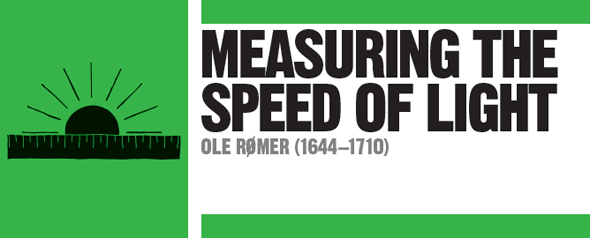
IN CONTEXT
Astronomy and physics
1610 Galileo Galilei discovers the four largest moons of Jupiter.
1668 Giovanni Cassini publishes the first accurate tables predicting eclipses of the moons of Jupiter.
1729 James Bradley calculates a speed of light of 301,000km/s (185,000 miles/s) based on variations in the positions of stars.
1809 Jean-Baptiste Delambre uses 150 years’ worth of observations of Jupiter’s moons to calculate a speed of light of 300,300km/s (186,600 miles/s).
1849 Hippolyte Fizeau measures the speed of light in a laboratory, rather than using astronomical data.
Jupiter has many moons, but only the four largest (Io, Europa, Ganymede, and Callisto) were visible through a telescope at the time that Ole Rømer was observing the skies of northern Europe, in the late 17th century. These moons are eclipsed as they pass through the shadow cast by Jupiter and at certain times they can be observed either entering or leaving the shadow, depending on the relative positions of Earth and Jupiter around the Sun. For nearly half of the year, the eclipses of the moons cannot be observed at all, because the Sun is between Earth and Jupiter.
Giovanni Cassini, the director of the Royal Observatory in Paris when Rømer started work there in the late 1660s, published a set of tables predicting the moons’ eclipses. Knowing the times of these eclipses provided a new way to work out longitude. The measurement of longitude depends on knowing the difference between the time at a given location and the time at a reference meridian (in this case, Paris). On land at least, it was now possible to calculate longitude by observing the time of an eclipse of one of Jupiter’s moons and comparing it to the predicted time of the eclipse in Paris. It was not possible to hold a telescope steadily enough onboard ship to observe the eclipses, and measuring longitude at sea remained impossible until John Harrison built the first marine chronometers – clocks that could keep time at sea – in the 1730s.

Finite or infinite speed?
Rømer studied observations of the eclipses of the moon Io taken over a period of two years and compared these to the times predicted by Cassini’s tables. He found a discrepancy of 11 minutes between observations taken when Earth was closest to Jupiter and those taken when it was furthest away. This discrepancy could not be explained by any of the known irregularities in the orbits of Earth, Jupiter, or Io. It had to be the time it took for light to travel the diameter of Earth’s orbit. Knowing the diameter of Earth’s orbit, Rømer could now calculate the speed of light. He produced a figure of 214,000km/s (133,000 miles/s). The current value is 299,792km/s (186,282 miles/s), so Rømer’s calculation was out by about 25 per cent. Nevertheless, this was an excellent first approximation, and it solved the previously open question as to whether light had a finite speed.
In England, Isaac Newton readily accepted Rømer’s hypothesis that light did not travel instantaneously. However, not everyone agreed with Rømer’s reasoning. Cassini pointed out that discrepancies in the observations of the other moons were still not accounted for. Rømer’s findings were not universally accepted until English astronomer James Bradley produced his more accurate figure for the speed of light in 1729 by measuring the parallax of stars.

From position 1 on Earth’s orbit, the predicted eclipse of Jupitier’s moon Io appears to occur later than from position 2. Rømer reasoned that this was due to the extra distance light from Io had to travel to reach Earth in position 1.
"For the distance of about 3,000 leagues, which is nearly equal to the diameter of the Earth, light needs not one second of time."
Ole Rømer
OLE RØMER
Born in the Danish city of Aarhus in 1644, Ole Rømer studied at the University of Copenhagen. On leaving university, he helped to prepare the astronomical observations of Tycho Brahe for publication. Rømer also made his own observations, recording the times of the eclipses of Jupiter’s moons from Brahe’s old observatory at Uraniborg, near Copenhagen. From there, he moved to Paris, where he worked at the Royal Observatory under Giovanni Cassini. In 1679, he visited England and met Isaac Newton.
Returning to the University of Copenhagan in 1681, Rømer became professor of astronomy. He was involved in modernizing weights and measures, the calendar, and building codes, and even the water supplies. Unfortunately, his astronomical observations were destroyed in a fire in in 1728.
Key work
1677 On the Motion of Light
See also: Galileo Galilei • John Michell • Léon Foucault